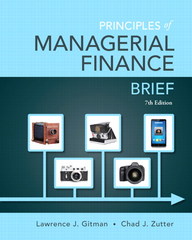only need questions 1-3 thank you

CH S&S AIR'S MORTGAGE Cark Sexton and Todd Story, the owners of S&S Air, Minec Inc.. were impressed by the work Chris had done on financial planning. Using Chriss analysis, and look- ng at the demand for light aircraft, they have decided that their existing fabrication equipment is sufficient, but it is time to acquire a bigger manufacturing facility Mark and Todd have identified a suitable structure that is currently for sale, and they believe they can buy and refurbish it for about $22 milion. Mark, Todd, and Chris are now ready to meet with Christie Vaughan, the loan officer for First United National Bank. The meeting is to discuss the mortgage options available to the company to finance the new facility Christie begins the meeting by discussing a 30-year mortgage. The loan would be repaid in equal monthly installments. Because of the previous relationship be- tweon S&S Air and the bank, there would be no closing costs for the loan. Christie states that the APR of the loan would be 6.1 porcent. Todd asks if a shorter mort- gage loan is available. Christie says that the bank doos have a 20-year mortgage available at the same APR. Merk decides to ask Christie about a "smart loan" he discussed with a mortgage broker when he was re- financing his home loan. A smart loan works as follows: Every two weeks a mortgage payment is made that is ecoctly one-half of the traditional monthly mortgage pay- ment. Christie informs him that the bank does have smart loans. The APR of the smart loan would be the same as the APR of the traditional loan, Mark nods his head. He then states this is the best mortgage option available to the company since it saves interest payments. Christie agrees with Mark, but then suggests that a bullet loan, or balloon payment would result in the greatest interest savings. At Todd's prompting, she goes on to explain a bullet loan. The monthly payments of a bullet loon would be calculated using a 30-year tra- ditional mortgage. In this case, there would be a 5-year bullet. This would mean that the company would make the mortgage payments for the traditional 30-year mort- gage for the first five years, but immediately after the company makes the 60th payment, the bullet payment would be due. The bullet payment is the remaining prin- cipal of the loan. Chris then asks how the bullet pay- ment is calculated. Christie tolls him that the remaining principal can be calculated using an amortization table, but it is also the present value of the remaining 25 years of mortgage payments for the 30-year mortgage. Todd has also heard of an interest-only loan and asks if this loan is available and what the terms would bo. Christio says that the bank offers an interest-only loan with a form of 10 years and an APR of 3.5 percent. She goes on to further explain the terms. The company would be responsible for making interest payments each month on the amount borrowed. No principal payments are required. At the end of the 10-year term, the com- pany would repay the $22 milion. However, the com- pany can make principal payments at any time. The principal payments would work just like those on a tra- ditional mortgage. Principal payments would reduce the principal of the loan and reduce the interest due on the next payment. Mark and Todd are satisfied with Christie's an- swers, but they are still unsure of which loan they should choose. They have asked Chris to answer the following questions to help them choose the correct mortgage MacBook Pro QUESTIONS 1. What are the monthly payments for a 30-year traditional mortgage? What are the payments for a 20-year traditional mortgage? 2. Prepare an amortization table for the first six months of the traditional 30-year mortgage. How much of the first payment goes toward principal? 3. How long would it take for S&S Air to pay off the smart loan assuming 30-year traditional mortgage payments? Why is this shorter than the time needed to pay off the traditional mortgage? How much interest would the company save? 14. Assume S&S Air takes out a bullet loan under the terms described. What are the payments on the ban? 5. What are the payments for the interest-only loan? 6. Which mortgage is the best for the company? Are there any potential risks in this action? 161









